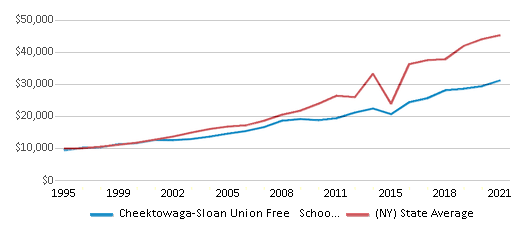Top Rankings
Cheektowaga-Sloan Union Free School District ranks among the top 20% of public school district in New York for:
Category
Attribute
Diversity
Most diverse schools (Top 1%)
For the 2025 school year, there is 1 public preschool serving 339 students in Cheektowaga-Sloan Union Free School District.
Public Preschools in Cheektowaga-Sloan Union Free School District have a diversity score of 0.67, which is less than the New York public preschool average of 0.73.
Minority enrollment is 47% of the student body (majority Asian and Black), which is less than the New York public preschool average of 62% (majority Hispanic).
Overview
This School District
This State (NY)
# Schools
4 Schools
1,575 Schools
# Students
1,258 Students
680,405 Students
# Teachers
116 Teachers
57,270 Teachers
Student : Teacher Ratio
11:1
11:1
District Rank
Cheektowaga-Sloan Union Free School District, which is ranked #836 of all 1,015 school districts in New York (based off of combined math and reading proficiency testing data) for the 2021-2022 school year.
The school district's graduation rate of 80-84% has stayed relatively flat over five school years.
Overall District Rank
#830 out of 1020 school districts
(Bottom 50%)
(Bottom 50%)

Math Test Scores (% Proficient)
33%
46%

Reading/Language Arts Test Scores (% Proficient)
35%
49%

Science Test Scores (% Proficient)
76%
78%

Graduation Rate
80-84%
87%

Students by Ethnicity:
Diversity Score
0.58
0.73
# American Indian Students
7 Students
6,882 Students
% American Indian Students
1%
1%
# Asian Students
124 Students
74,011 Students
% Asian Students
10%
11%
# Hispanic Students
106 Students
208,386 Students
% Hispanic Students
8%
31%
# Black Students
125 Students
108,146 Students
% Black Students
10%
16%
# White Students
784 Students
257,567 Students
% White Students
62%
38%
# Hawaiian Students
4 Students
1,683 Students
% Hawaiian Students
n/a
n/a
# Two or more races Students
107 Students
23,663 Students
% of Two or more races Students
9%
3%
Students by Grade:
# Students in PK Grade:
60
62,211
# Students in K Grade:
84
99,006
# Students in 1st Grade:
102
97,399
# Students in 2nd Grade:
93
96,389
# Students in 3rd Grade:
93
87,433
# Students in 4th Grade:
91
87,229
# Students in 5th Grade:
87
81,167
# Students in 6th Grade:
103
24,209
# Students in 7th Grade:
99
13,778
# Students in 8th Grade:
80
14,339
# Students in 9th Grade:
103
2,893
# Students in 10th Grade:
106
2,861
# Students in 11th Grade:
78
2,527
# Students in 12th Grade:
75
2,549
# Ungraded Students:
4
6,415
District Revenue and Spending
The revenue/student of $30,572 in this school district is less than the state median of $31,307. The school district revenue/student has stayed relatively flat over four school years.
The school district's spending/student of $25,644 is less than the state median of $32,183. The school district spending/student has stayed relatively flat over four school years.
Total Revenue
$39 MM
$78,541 MM

Spending
$32 MM
$80,737 MM

Revenue / Student
$30,572
$31,307

Spending / Student
$25,644
$32,183

Best Cheektowaga-Sloan Union Free School District Public Preschools (2025)
School
(Math and Reading Proficiency)
(Math and Reading Proficiency)
Location
Grades
Students
Rank: n/an/a
2495 William St
Buffalo, NY 14206
(716) 891-6424
Buffalo, NY 14206
(716) 891-6424
Grades: PK-2
| 339 students
Recent Articles

Sexual Harassment at Age 6: The Tale of a First Grade Suspension
A six-year old in Aurora, Colorado, was suspended after singing an LMFAO song to a little girl in his class and reportedly “shaking his booty.” We look at the case and the sexual harassment problem in public schools today.

How Scaffolding Could Change the Way Your Child Learns
This article explores the concept of instructional scaffolding, a teaching method that enhances learning by breaking down complex tasks into manageable parts. It highlights how scaffolding supports students in developing critical thinking skills and becoming more independent learners. The article discusses the benefits of scaffolding, including improved engagement and reduced anxiety, and provides strategies for its implementation across various educational levels.

February 05, 2025
Understanding the U.S. Department of Education: Structure, Impact, and EvolutionWe explore how the Department of Education shapes American education, from its cabinet-level leadership to its impact on millions of students, written for general audiences seeking clarity on this vital institution.





